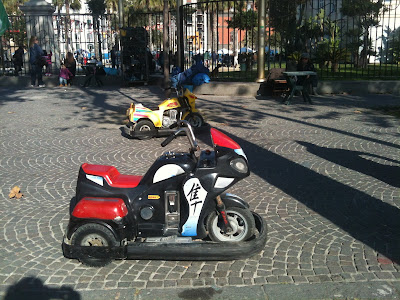 |
| Entrance to Castel Dell'Ovo |
First you need to know the story behind the castle.
Commune Napoli
"Castel dell' Ovo stands on the islet of Megaride. According to one of the most fanciful Neapolitan legends, the name of this castle derives from the egg that the Latin poet Virgil apparently hid in a cage placed in the dungeons of the castle. The egg was locked up and kept hidden because "the fortune of the Sea Castle depended on that egg".
Wikipedia says
The island of Megaride was where Greek colonists from Cumae founded the original nucleus of the city in the 6th century BC. Its location affords it an excellent view of the Naples waterfront and the surrounding area. In the 1st century BC the Roman patrician Lucius Licinius Lucullus built the magnificent villa Castellum Lucullanum on the site. Fortified by Valentinian III in the mid-5th century, it was the place to which the last western Roman emperor, Romulus Augustulus, was exiled in 476.[1] Eugippius founded a monastery on the site after 492.
The remains of the Roman-era structures and later fortifications were demolished by local residents in the 9th century to prevent their use by Saracen raiders. The first castle on the site was built by the Normans in the 12th century. The importance of the Castel dell'Ovo began to decline when king Charles I of Anjou built a new castle,Castel Nuovo, and moved his court there. Castel dell'Ovo became the seat of the Royal Chamber and of the State Treasury. The current appearance dates from the Aragonese domination (15th century). It was struck by French and Spanish artillery during the Italian Wars; in the Neapolitan Republic of 1799 its guns were used by rebels to deter the philo-Bourbon population of the city.
In the 19th century a small fishing village (Borgo Marinari) developed around the castle's eastern wall. This village remains, now known for its marina and restaurants.
What it is today
Without enough Italian language to read and understand all the signs about, we can merely show you photos at this point and give you some of our first hand observations.
The castle is extremely compact. By castle standards -- at least in my own imagination of what a castle should be -- this one is very small. Looks are deceiving however, when you get inside there are amazing passage ways all over and multiple levels. Tourist access is really only to the outer walkways and the one upper floor. There are at least two other levels visible that we could not access. I believe some of the rooms on the lower level are used now for special events.
This passage way is a gradual climb of steps but with very shallow rise. We speculated that a horse and cart could make this grade and because of how wide the path is, was probably used as a main passageway for bringing supplies and arms into the castle.
 |
| Close up of the ceiling supports |
 |
| Perfectly arched contours on these ancient walls |
From the main passage are dozens of narrow, winding staircases leading to where, we don't know.
The views of from the castle are beautiful. From a defensive and strategic point of view, this was an ideal location as no one could "sneak up" on you. Being situated in a deep water bay, it was also ideal of shipping and trade.
All good castles have gun ports ( or perhaps they are for archers?) ringing the outer edges. These are cleverly designed so the inside access is much larger that the outside openings.
There is also an upper level with canons at the ready.
 |
| Roof top canon battlement |
 |
| View southeast from the castle to the adjacent area with marina and restaurants |
After the tour of the Castle, we went next door to one of the many little cafes that ring the castle. This marina has some very beautiful boats and is a nice location to pass away a sunny afternoon.
 |
| Pavers typical of all historic Naples |
 |
| View of the castle wall from the Marina cafe |
 |
| Enjoying Sunday afternoon |





























